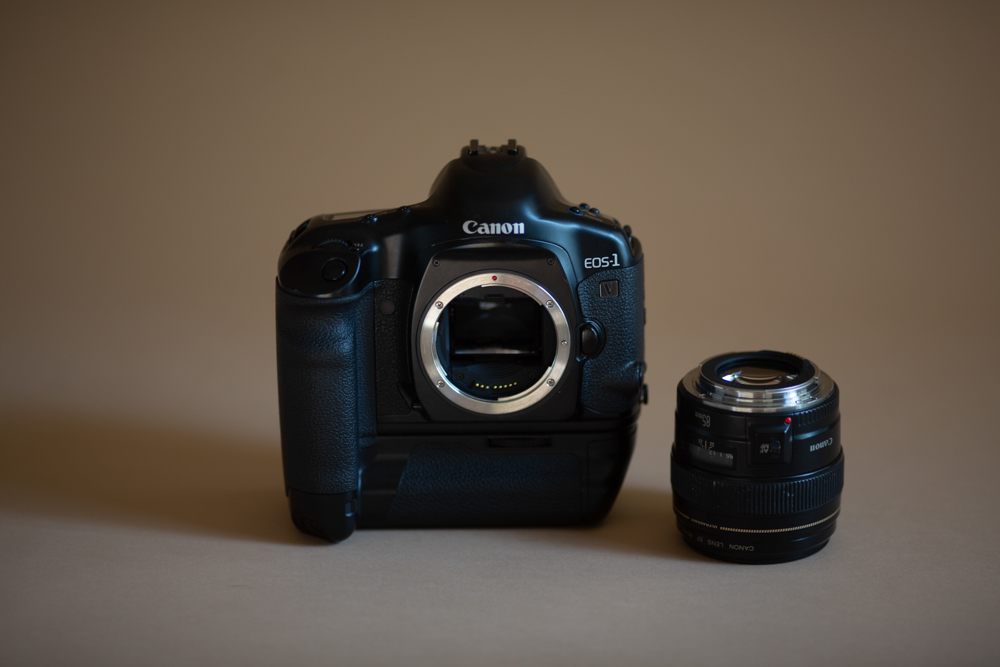Introduction to the Canon EOS-1V
When it was released in the year 2000, it was the greatest film camera ever made. In 2019... It is the greatest film camera ever made.
OK, perhaps claims of it being the best is somewhat debatable. Some may argue that Nikon’s f5 of 1996 was up there with the Canon 1V. But one thing is for sure, the Canon 1v represents the pinnacle of professional sports film cameras. It was the end of an era; The end of the line for flagship film cameras. It would be just two years later that Canon would release the digital 1D. We face something similar today in which the upcoming (yet to be announced) Canon 1DX iii, will likely bookend the legacy of the EF mount DSLR. I suspect we will see an RF mount version based on it within the next two years of its release.
Canon 1V with my 85mm 1.8.
How I got my 1V
I got my Canon 1v a few years ago when I realized that the poor college kid who could never afford decent gear could now easily buy Canon’s best for a mere $499. At the time of writing this article, they seem to be going for closer to $700 on average. Mine was in brand new condition and I was able to order it on Amazon.
But fulfilling my former, poorer self’s dreams was not the only reason to pick up a 1V. There are more and better reasons for having this camera other than having the best in class.
Familiarity
If you’re at all familiar with current pro DSLRs by Canon, you will feel right at home with the 1V. It’s form factor and button layout are all very Canon-like. I am able to use my 1V exactly as I would my 5diii. Including with back button focus, one of the most important things to me. The only thing you will find missing is a controller to set your auto focus point. Rather, setting your focus point is achieved by pressing the [•::::•] button and use a combination of your shutter dial and rear controller to move your focus. To this day, you can still set your focus point this way on most Canon cameras- even those with directional controllers.
Truthfully, as a professional event photographer, this would be a non starter for me with any new piece of gear. But although I would find a focus point controller welcome, I have found that not having one is not too much of a hindrance and I quickly got used to setting my focus point this way. In fact I have felt right at home shooting professional work this way and in practice it has hardly affected my hit rate of keepers.
Canon 1V with 70-200mm f2.8 and the 24-70mm f2.8
It’s The Lenses, Stupid
In addition to being instantly familiar with the layout and feel of the 1v, it is entirely compatible with all of my pro glass. Every EF lens I own works flawlessly with the 1V, including those with image stabilization. I have even used vintage m-42 glass on it using an adapter I bought for my 5diii.
Using this camera with all of my pro lenses is like living the dream of my former self. Sure, I have been shooting with pro glass professionally for 10 years, but that was always on digital bodies mostly doing work for other people. Shooting on the 1V is for me- Even when I use it at work, photograph events in Los Angeles.
EX Flash Compatibility
The 1V is completely compatible with all EX and EZ flash units. I even use Canon’s latest flagship flash, the 600 EX II-RT. Using TTL, the flash works exactly as it should and you can expect consistent results as you would with digital.
Build Quality, Durability, and Whether Sealing
The EOS-1V is almost entirely made of magnesium alloy. It is robust and feels great in the hand. This is a camera that can take a beating in just about any condition. But more importantly, as a Canon shooter, using it is a pure joy.
I personally really enjoy shooting with a variety of film cameras. I especially enjoy the ones with the most quirks (Anscomark m, Rollei 35s, Voigtlander Vito ii, etc.), often making them the most difficult to use. But when I want a camera that just does the job, effortlessly and in a way I am used to when working, I choose the 1V.
Design
Curved, with rounded edges, the Canon 1V is a camera that embraces design ethos of the 90s. It is a minimal camera. Missing are certain dedicated dials like you would find in the Minolta Alpha 9 or Nikon F5. The top left plate has just 3 buttons to control 7 different functions. Changing certain things like drive mode require you to press two buttons in unison and then rotating your shutter dial.
top left plate of the canon 1v.
Although I am someone that really enjoys the tactile experience of using a camera, the truth is that Canon’s choice in how you operate the camera in no way slow you down once you are used to it. In fact, by clustering everything together so that they are all operated in a similar way, I think there is an argument that the 1V is more efficient than having to reposition your hand to change various dials.
I’ll be honest, as a long time Canon shooter, I have always visually admired the hard lines of Nikon cameras. But design-wise, Canon cameras have always just made sense to me.
Features
Feature wise, the 1V is designed for working professionals. It’s 45 point Autofocus system is fast even by today’ standards. Everything a working professional needs is at their fingertips and nothing more. Because I want to focus on sharing what it is like to use the camera, I am going to avoid listing off specs here. However, I will link to a resource for that and to a full spec sheet at the end of this article.
Interesting Features Worth Noting
The Canon is capable of roll number imprinting. Is this feature useful to you? Maybe not. I have yet to use it, but I may play around with it a bit. I think this was most useful in determining who shot what when multiple rolls are developed by a team of photographers.
The 1V also tracks exposure data. For sure this could come in handy, but accessing it requires dated software on a dated computer. It’s not worth the trouble to me.
With the 1V you can register a focus point so that you can instantly return to it. This feature is still present in current Canon cameras. I do not use it too often, but I am sure to some it may be helpful. By default, this is set to the middle autofocus point.
My favorite interesting feature of the 1V is the ability to set it to leave your film leader out when you rewind. As someone that develops all their films at home, I love not having to break open a roll to load it onto a reel. Click here to see my savage method of opening film cassettes.
Rear view of the Canon 1V.
Purchasing the 1V
If it’s not already clear to you, any film shooter with existing L grade glass that wants top notch shooting experience and quality of images should own a 1V. I think wedding photographers and event photographers like myself will especially enjoy using it. When searching for a 1V keep in mind that there are two versions: the base 1V and the 1V HS. The HS model is identical but includes a battery grip that brings its shooting speed up to 10 FPS. However there are 3 different grips that are compatible with the camera in total. I personally use one I rescued from a Canon 1n. It had lots of battery corrosion, but with some white vinegar and q tips I was able to clear it up.
I bought my 1V on Amazon just a few years ago for $499 with prime shipping and it was worth every penny. It was in like new condition and included the box with all its accessories. At the time of writing this article, prices seem to be averaging around $700 and I doubt they are in the condition mine was in. I anticipate costs going up for the foreseeable future, so I would not hesitate in buying one if you’re interested.
The 1V was a camera built for and used by working professionals. It is not a Leica or collectors item. Because of this, you can expect a fair amount of them to be beat up by now. However, it stayed in production until somewhat recently so you should be able to find some in solid condition.
Conclusion
For any film shooter with existing EF glass, the 1V is a must own piece of equipment.
If you’re a working professional photographer shooting a mix of film and digital, throw it in your bag and effortlessly swap between the two without the need for separate lenses.
If you want a professional grade film camera that reliably gets the job done with the modern features you’ve come to love and rely on, then the Canon 1V will feel right at home, all while delivering top notch image quality from your pro lenses.
In the digital age, the best film camera of 2000 will stay the best for the foreseeable future. Do yourself a favor and get one now.




